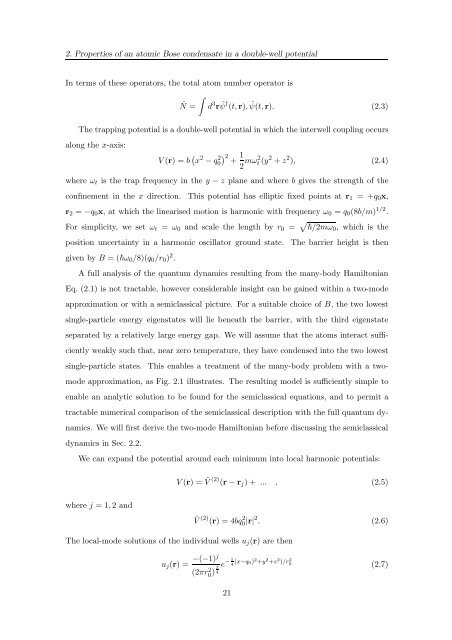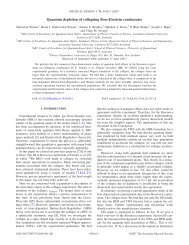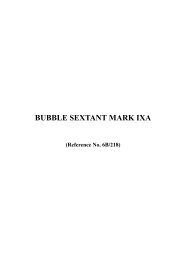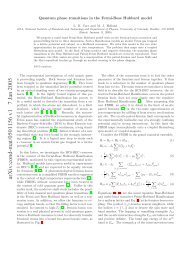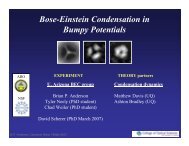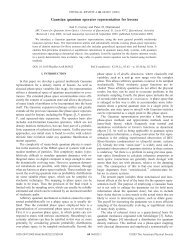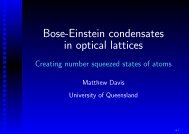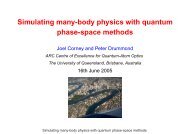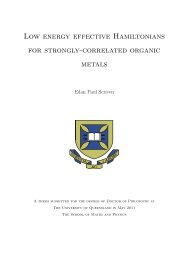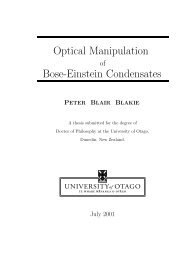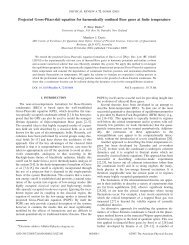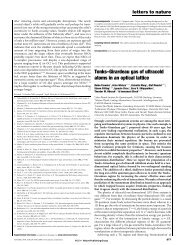Open Quantum Dynamics of Mesoscopic Bose-Einstein ... - Physics
Open Quantum Dynamics of Mesoscopic Bose-Einstein ... - Physics
Open Quantum Dynamics of Mesoscopic Bose-Einstein ... - Physics
You also want an ePaper? Increase the reach of your titles
YUMPU automatically turns print PDFs into web optimized ePapers that Google loves.
2. Properties <strong>of</strong> an atomic <strong>Bose</strong> condensate in a double-well potentialIn terms <strong>of</strong> these operators, the total atom number operator is∫ˆN = d 3 r ˆψ † (t, r), ˆψ(t, r). (2.3)The trapping potential is a double-well potential in which the interwell coupling occursalong the x-axis:V (r) =b ( x 2 − q02 ) 2 1 +2 mω2 t (y 2 + z 2 ), (2.4)where ω t is the trap frequency in the y − z plane and where b gives the strength <strong>of</strong> theconfinement in the x direction. This potential has elliptic fixed points at r 1 =+q 0 x,r 2 = −q 0 x, at which the linearised motion is harmonic with frequency ω 0 = q 0 (8b/m) 1/2 .For simplicity, we set ω t = ω 0 and scale the length by r 0 = √ /2mω 0 ,whichistheposition uncertainty in a harmonic oscillator ground state.The barrier height is thengiven by B =(ω 0 /8)(q 0 /r 0 ) 2 .A full analysis <strong>of</strong> the quantum dynamics resulting from the many-body HamiltonianEq. (2.1) is not tractable, however considerable insight can be gained within a two-modeapproximation or with a semiclassical picture. For a suitable choice <strong>of</strong> B, thetwolowestsingle-particle energy eigenstates will lie beneath the barrier, with the third eigenstateseparated by a relatively large energy gap. We will assume that the atoms interact sufficientlyweakly such that, near zero temperature, they have condensed into the two lowestsingle-particle states. This enables a treatment <strong>of</strong> the many-body problem with a twomodeapproximation, as Fig. 2.1 illustrates. The resulting model is sufficiently simple toenable an analytic solution to be found for the semiclassical equations, and to permit atractable numerical comparison <strong>of</strong> the semiclassical description with the full quantum dynamics.We will first derive the two-mode Hamiltonian before discussing the semiclassicaldynamics in Sec. 2.2.We can expand the potential around each minimum into local harmonic potentials:V (r) =Ṽ (2) (r − r j )+ ... , (2.5)where j =1, 2andṼ (2) (r) =4bq 2 0|r| 2 . (2.6)The local-mode solutions <strong>of</strong> the individual wells u j (r) arethenu j (r) = −(−1)j(2πr0 2) e − 1 3 4 (x−q 0) 2 +y 2 +z 2 )/r0 2 (2.7)421


